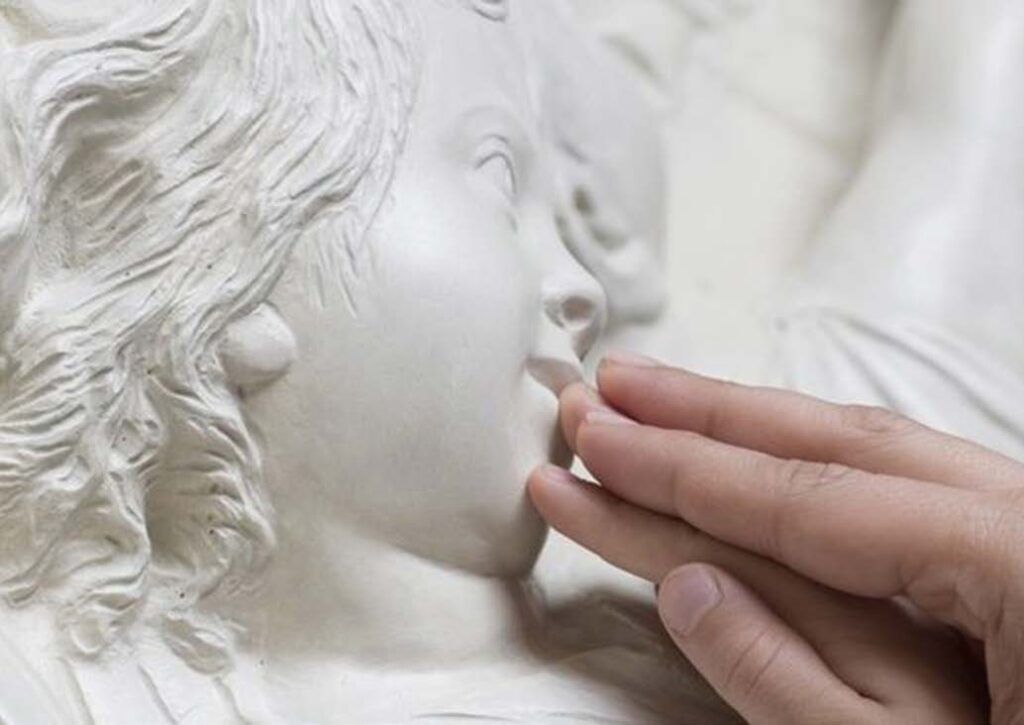
Art, smart cities and accessibility: ETT presents the product Sense at the Science Festival 2023 in the RAISE Innovation Village.
Sense is a full-scale, tactile and sensory reproduction of a work of art. Born as an accessibility project to help blind and partially sighted people enjoy art, it is now a product that uses multisensoryity in an innovative way.
The product will be presented on 27 October 2023 as part of the RAISE Innovation Village programme at Porto Antico – Porta Siberia in Genoa.
SENSE, an ETT product presented to the media during the Genoa Festival of Science, was born as a project related to the theme of accessibility, in order to facilitate the enjoyment of art by the blind and visually impaired public; now it can be considered more generally as a product that allows a new way of exploring a work of art through multi-sensoriality, and of enjoying spaces and content from a smart city perspective.
The first prototype was created by Manuela Serando, content specialist and cultural project manager at ETT, the project’s technological partner, as part of a doctoral thesis on the study and enhancement of historical, artistic, architectural and environmental heritage at the University of Genoa. The project focused on the bronze bas-reliefs by Giambologna, a Flemish sculptor (16th century) who worked mainly in Florence and who combined the Nordic taste for the representation of the smallest details with the canons of Italian perspective.
To enable the blind and partially sighted to appreciate the structural and stylistic complexity of the compositions, a 1:1 model of the bronze bas-relief of the Deposition in the Tomb has been created, linked to a synchronised audio guide thanks to a system of sensors. The model thus combines tactile perception with the added value of narration. The special sensors used allow the content to be activated by simple contact with the surface, significantly breaking down the barriers between the public and the work. Hands are free to move and explore the model independently, without mediation that can ‘alter’ the cognitive and relational experience.
Giovanni Verreschi, CEO of ETT SPA, said: “The realisation of the SENSE product has involved ETT in the important issue of accessibility of artistic content in a logic of ‘design for all’. We believe that this is an area where there is still much to be done and achieved, requiring a multidisciplinary commitment. Indeed, skills are needed both on the artistic-philological side, for example to study the author and the historical contextualisation of a work in depth, and on the technological side, for the realisation of the three-dimensional model and an audio that matches the complexity of the content. Faced with such a broad commitment, we can say that the realisation of SENSE is a challenge for ETT to make our creative contribution functional to an accessible conception of spaces and functions, including aesthetic enjoyment and the relationship with the contents presented“.
The creation of the relief with sensors and audio guide involves several stages: laser scanning of the original, 3D printing (rapid prototyping) of the model divided into blocks, assembly of the various printed parts with treatment to minimise joints, and finishing and application of the sensors. This requires a precise study of the content and the way it is to be conveyed, combining historical-artistic knowledge and narrative techniques with the principles of haptic (tactile) perception. Fundamental and indispensable to the realisation of a truly accessible product was the design phase of experimentation and testing, carried out in collaboration with blind and visually impaired volunteers, in partnership with UICI – Italian Union of the Blind and Visually Impaired.
A sensorialised typhlodidactic model (for the learning of the visually impaired) by ETT is already available at Palazzo Rosso in Via Garibaldi in the historic centre of Genoa, where it is possible to enjoy the artistic and architectural heritage of Strada Nuova, the Via Aurea of the ancient Renaissance and Baroque city, in an easy-to-use manner. In this case, the public will be invited to experience the museums and sixteenth-century buildings in a technological and immersive way, with contextual information that will lead to a better understanding of these buildings.
The aim of the project was to encourage an unprecedented enjoyment of the artistic and cultural heritage of the city’s main street. The reproduction of the multisensory model, with synchronised audio and video guide in LIS, shows the layout of the street at the end of the 16th century, including the gardens of the various palaces and the destroyed complex of San Francesco di Castelletto.
